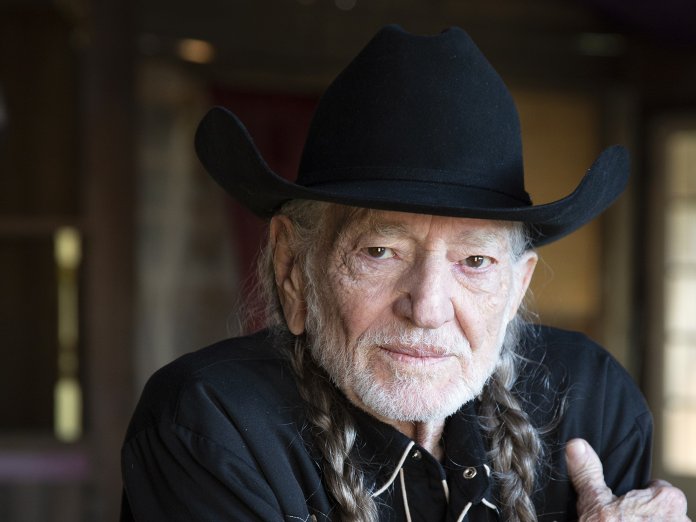As Bob Dylan may tell you, covering Frank Sinatra classics is not without its risks. Comparisons with Sinatra’s vocal agility is one problem – they didn’t call him The Voice for nothing – while his versions of a large swathe of the Great American Songbook remain definitive, indelibly stamped with his personality and the Rat Pack panache of his prime. Frank liked to own a song.
Willie Nelson is no stranger to either Sinatra or the American songbook. He was an aspiring 22-year-old DJ when Sinatra delivered In The Wee Small Hours in 1955 (its sleeve design is echoed here), and a few years later, when Nelson was singing on Saturday nights at Houston’s Esquire ballroom, Sinatra numbers were surely in the repertoire. They were certainly on the charts. Throughout his twenties Willie was writing country variants of the Songbook – numbers like “Crazy” and “Hello Walls”. Nelson the button-down balladeer predates Willie the bandana’d outlaw by some time.
Since then, Willie has regularly returned to the Songbook and its creators, beginning with 1978’s Stardust, a set of standards quite at odds with his persona as rebel honcho, and whose idiosyncratic charms delivered his biggest commercial success. Willie didn’t bother replicating originals like “All Of Me”, he delivered alternative versions tinged with country and jazz. His guitar playing, still underrated today, helped.
Nelson’s early years fronting a ballroom band are beautifully evoked by the opener here, “Nice Work If You Can Get It”, taken at a brisk pace with a tinge of western swing in the arrangements – dance music, in fact. Willie’s at ease, with nothing to prove but his bonhomie.
Not everything here is such a happy fit. Both That’s Life and his 2018 Sinatra record My Way are meant to be cast in the slightly eclectic mould of Stardust, but mostly adhere to a Sinatra-esque formula of complex brass arrangements, supplemented by syrupy strings. Producer Buddy Cannon understands an orchestra, but massed horns don’t always suit Nelson, who at 87 no longer has the vocal chops (if he ever did) to ride a big band. He copes gamely on upbeat numbers like “You Make Me Feel So Young”, “Just In Time” and “Luck Be A Lady”, but on “You Make Me Feel So Young” he simply gets blown away, subsumed by the growling brass. The mismatch is more glaring still on “I Got You Under My Skin”, where a clumsy samba rhythm (it doesn’t sway, not a bit) evades Nelson, who simply sings on regardless of what is happening behind him.
Nelson has always taken liberties with timing, hanging back on a word or phrase or delivering it early – he has often been accused of ‘talking the lyrics’ rather than singing them. It’s a skill set picked up from Sinatra himself – “Frank didn’t worry about being behind the beat or in front of the beat – he could sing it either way, and that’s the feel you have to have.” The mutual admiration that developed between Sinatra and Nelson was founded in part by their vocal looseness.
For intimacy and authenticity, less musical architecture often proves better. The comparatively minimalist title track is a case in point. Sinatra delivered the song (a major hit in ’66) at full blast, as a piece of high-kicking, top-of-the-heap defiance. Befitting his years, Nelson turns it into weathered philosophising – ‘pauper, pirate, poet’, been there, done that. The crying harmonica here is surplus to requirements and shows up again on “In The Wee Small Hours”. No-one has yet captured the sense of desolation that Sinatra squeezed from the song, and nor does Willie, though he lays on the pathos. Willie doesn’t mind being schmaltzy – it works well on “Cottage For Sale”, for example – coming as he does from an age when sentimentality was welcomed, not shunned (not much schmaltz in “Like A Rolling Stone”, by contrast).
The earliest number here is 1927’s “Lonesome Road”, a gospel call that was an odd fit for Sinatra, for whom ‘Gabriel’s horn’ probably announced the next round of martinis, and Nelson and his team struggle to find much enthusiasm for its pilgrim spirit. At the other end of proceedings comes Jerome Kern’s “I Won’t Dance”, a dizzy duet with Diana Krall that’s a companion piece to the duet with Norah Jones on My Way’s “What Is This Thing Called Love”. Krall, who can do pyrotechnics when she chooses, instead keeps things cool and playful while Willie plays straight man, delivering a husky version of Astaire rather than Sinatra.
Comparisons between the two halves of Willie’s homage to Ol’ Blue Eyes puts them about level, though My Way has the more mellow, accessible numbers. Sinatra would be delighted, as Nelson undoubtedly is with his 71st studio album. Ring a ding ding.



